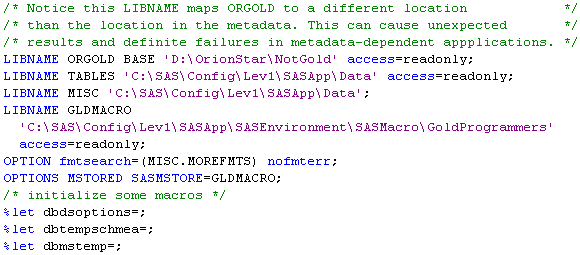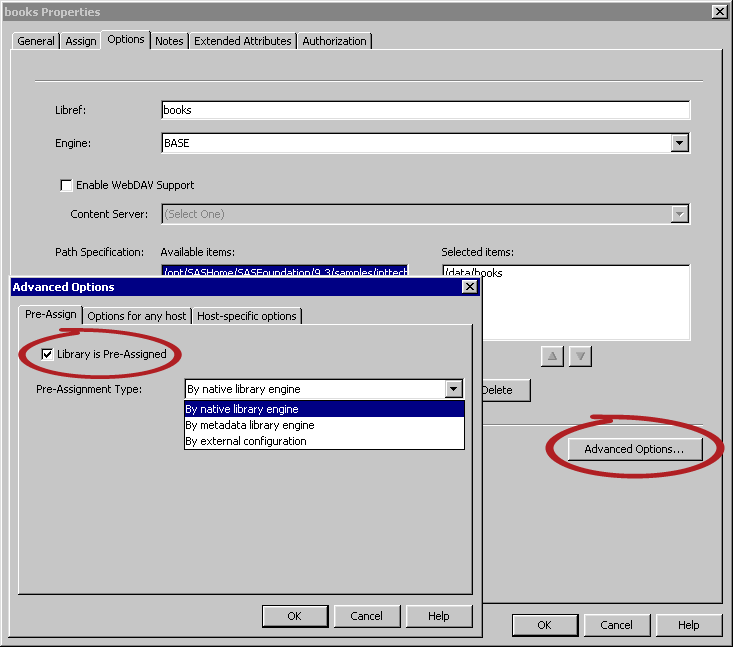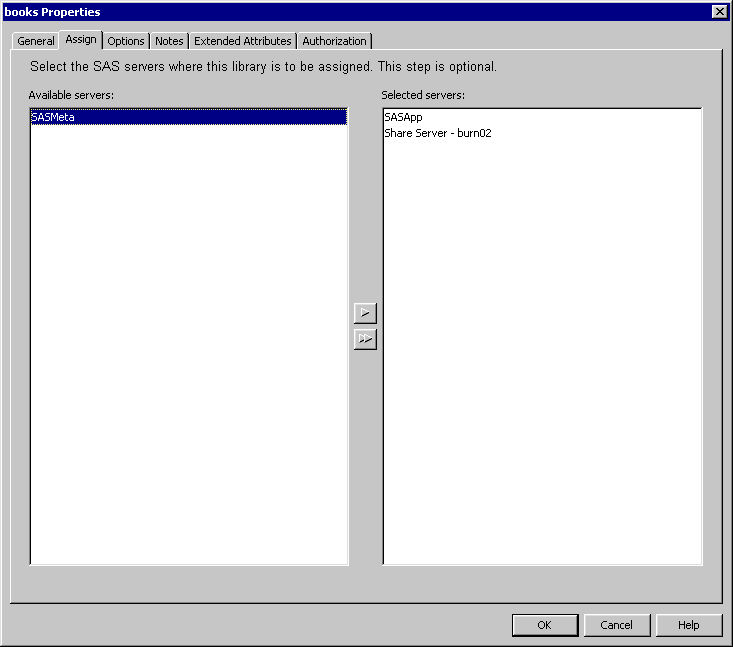Pre-assigning a Library
Overview of Pre-assigning a Library
Stage 1: Flag the Library as Pre-assigned
Stage 2: Edit the Configuration Files
In the previous stage,
the library was flagged as pre-assigned. You also selected which servers
can retrieve the library definitions from metadata. In this stage,
you edit the
sasv9_usermods.cfg file
for the same servers that were selected in the previous stage and
add a METAAUTORESOURCES SAS system option. This option is used so
that the servers read the library definitions from metadata as they
start.
Note: This stage is not needed
for workspace servers, pooled workspace servers, stored process servers,
SAS/SHARE servers, or OLAP servers. Those server types automatically
read metadata when they start and assign the libraries.
Pre-assigning Libraries to Use the Metadata Engine
If You Do Not Need to Create or Delete Tables
Pre-assigning a library
to use the metadata engine is available by selecting the By metadata library engine option for a library on the Advanced Options dialog box. Using this option results
in using the metadata engine with the METAOUT=ALL option. This LIBNAME
option specifies that you can read, create, update, and delete observations
in physical tables that already exist and are registered in metadata.
You cannot create or delete entire physical tables.
If You Need to Create or Delete Tables
Other METAOUT= LIBNAME
options exist. For example, the METAOUT=DATA option permits reading,
creating, updating, and deleting physical tables. The METAOUT=DATAREG
setting permits reading, updating, and deleting tables registered
in metadata as well as creating new physical tables. Be aware that
new physical tables cannot be read until they are registered in metadata.
For more information, see the “METAOUT= Argument” in SAS Language Interfaces to Metadata.
If the METAOUT=ALL
setting does not meet your business needs, but the data-level authorizations
do meet your business needs, you can pre-assign the library to use
the metadata engine in a configuration file. To do so, perform the
following high-level steps:
-
Follow all the steps in Stage 1: Flag the Library as Pre-assigned. When you set the pre-assignment type in step 4, select By external configuration.
-
Construct a LIBNAME statement that uses the metadata engine and your preferred METAOUT= option. For an example, see Metadata LIBNAME Engine Statement.
-
Determine which autoexec file to use for the LIBNAME statement. For more information, see SAS Application Server Autoexec Files.
Pre-assigning Libraries in an Autoexec File
Pre-assigning
libraries in an autoexec file is not a recommended as a routine practice
because library assignments are recorded in two places, the autoexec
file and metadata. Having configuration information in two places
increases maintenance. An autoexec file is a text file that contains
SAS statements that are executed when the server process starts. If
an autoexec file is used in your environment, it is important to note
that the LIBNAME statements in the autoexec file take precedence over
same-named libraries assigned by to the server in metadata. For example,
if ORGOLD is registered in the metadata to be pre-assigned, and ORGOLD
is also defined in an autoexec for the same server, the ORGOLD library
is assigned using the LIBNAME information from the autoexec file.
Simply put, the library assignment in the autoexec file always takes
precedence.
To pre-assign a library
in an autoexec file, perform the following high-level steps:
-
Follow all the steps in Stage 1: Flag the Library as Pre-assigned. When you set the pre-assignment type in step 4, select By external configuration.
-
Determine which autoexec file to use for the LIBNAME statement. For more information, see SAS Application Server Autoexec Files.
The following display
shows LIBNAME statements that pre-assign libraries in an autoexec
file. The comments in the display acknowledge how pre-assigning a
library in an autoexec file and registering the same library in metadata
can cause unexpected results when accessing data.
Library Assignment in an Autoexec File

SAS Application Server Autoexec Files
During the configuration
process, the SAS Deployment Wizard created a single file named
appserver_autoexec_usermods.sas that controls all
component servers of the SAS Application Server and files named autoexec_usermods.sas for each of the component servers
of the application server:
-
Use this file to modify one of the SAS Application Server components, such as the workspace server, to use the engine specified in the LIBNAME statement, but to leave the other server components unchanged. If this is your choice, then note that the autoexec_usermods.sas file is located within a subdirectory, such as
C:\SAS\Config\Lev1\SASApp\WorkspaceServer\.

